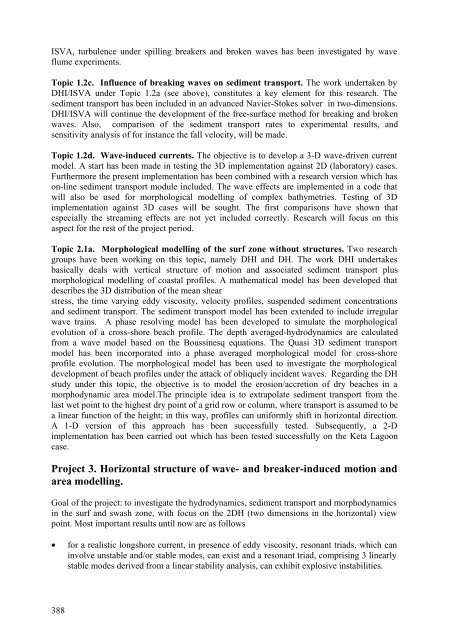EurOCEAN 2000 - Vlaams Instituut voor de Zee
EurOCEAN 2000 - Vlaams Instituut voor de Zee
EurOCEAN 2000 - Vlaams Instituut voor de Zee
You also want an ePaper? Increase the reach of your titles
YUMPU automatically turns print PDFs into web optimized ePapers that Google loves.
ISVA, turbulence un<strong>de</strong>r spilling breakers and broken waves has been investigated by wave<br />
flume experiments.<br />
Topic 1.2c. Influence of breaking waves on sediment transport. The work un<strong>de</strong>rtaken by<br />
DHI/ISVA un<strong>de</strong>r Topic 1.2a (see above), constitutes a key element for this research. The<br />
sediment transport has been inclu<strong>de</strong>d in an advanced Navier-Stokes solver in two-dimensions.<br />
DHI/ISVA will continue the <strong>de</strong>velopment of the free-surface method for breaking and broken<br />
waves. Also, comparison of the sediment transport rates to experimental results, and<br />
sensitivity analysis of for instance the fall velocity, will be ma<strong>de</strong>.<br />
Topic 1.2d. Wave-induced currents. The objective is to <strong>de</strong>velop a 3-D wave-driven current<br />
mo<strong>de</strong>l. A start has been ma<strong>de</strong> in testing the 3D implementation against 2D (laboratory) cases.<br />
Furthermore the present implementation has been combined with a research version which has<br />
on-line sediment transport module inclu<strong>de</strong>d. The wave effects are implemented in a co<strong>de</strong> that<br />
will also be used for morphological mo<strong>de</strong>lling of complex bathymetries. Testing of 3D<br />
implementation against 3D cases will be sought. The first comparisons have shown that<br />
especially the streaming effects are not yet inclu<strong>de</strong>d correctly. Research will focus on this<br />
aspect for the rest of the project period.<br />
Topic 2.1a. Morphological mo<strong>de</strong>lling of the surf zone without structures. Two research<br />
groups have been working on this topic, namely DHI and DH. The work DHI un<strong>de</strong>rtakes<br />
basically <strong>de</strong>als with vertical structure of motion and associated sediment transport plus<br />
morphological mo<strong>de</strong>lling of coastal profiles. A mathematical mo<strong>de</strong>l has been <strong>de</strong>veloped that<br />
<strong>de</strong>scribes the 3D distribution of the mean shear<br />
stress, the time varying eddy viscosity, velocity profiles, suspen<strong>de</strong>d sediment concentrations<br />
and sediment transport. The sediment transport mo<strong>de</strong>l has been exten<strong>de</strong>d to inclu<strong>de</strong> irregular<br />
wave trains. A phase resolving mo<strong>de</strong>l has been <strong>de</strong>veloped to simulate the morphological<br />
evolution of a cross-shore beach profile. The <strong>de</strong>pth averaged-hydrodynamics are calculated<br />
from a wave mo<strong>de</strong>l based on the Boussinesq equations. The Quasi 3D sediment transport<br />
mo<strong>de</strong>l has been incorporated into a phase averaged morphological mo<strong>de</strong>l for cross-shore<br />
profile evolution. The morphological mo<strong>de</strong>l has been used to investigate the morphological<br />
<strong>de</strong>velopment of beach profiles un<strong>de</strong>r the attack of obliquely inci<strong>de</strong>nt waves. Regarding the DH<br />
study un<strong>de</strong>r this topic, the objective is to mo<strong>de</strong>l the erosion/accretion of dry beaches in a<br />
morphodynamic area mo<strong>de</strong>l.The principle i<strong>de</strong>a is to extrapolate sediment transport from the<br />
last wet point to the highest dry point of a grid row or column, where transport is assumed to be<br />
a linear function of the height; in this way, profiles can uniformly shift in horizontal direction.<br />
A 1-D version of this approach has been successfully tested. Subsequently, a 2-D<br />
implementation has been carried out which has been tested successfully on the Keta Lagoon<br />
case.<br />
Project 3. Horizontal structure of wave- and breaker-induced motion and<br />
area mo<strong>de</strong>lling.<br />
Goal of the project: to investigate the hydrodynamics, sediment transport and morphodynamics<br />
in the surf and swash zone, with focus on the 2DH (two dimensions in the horizontal) view<br />
point. Most important results until now are as follows<br />
• for a realistic longshore current, in presence of eddy viscosity, resonant triads, which can<br />
involve unstable and/or stable mo<strong>de</strong>s, can exist and a resonant triad, comprising 3 linearly<br />
stable mo<strong>de</strong>s <strong>de</strong>rived from a linear stability analysis, can exhibit explosive instabilities.<br />
388

















